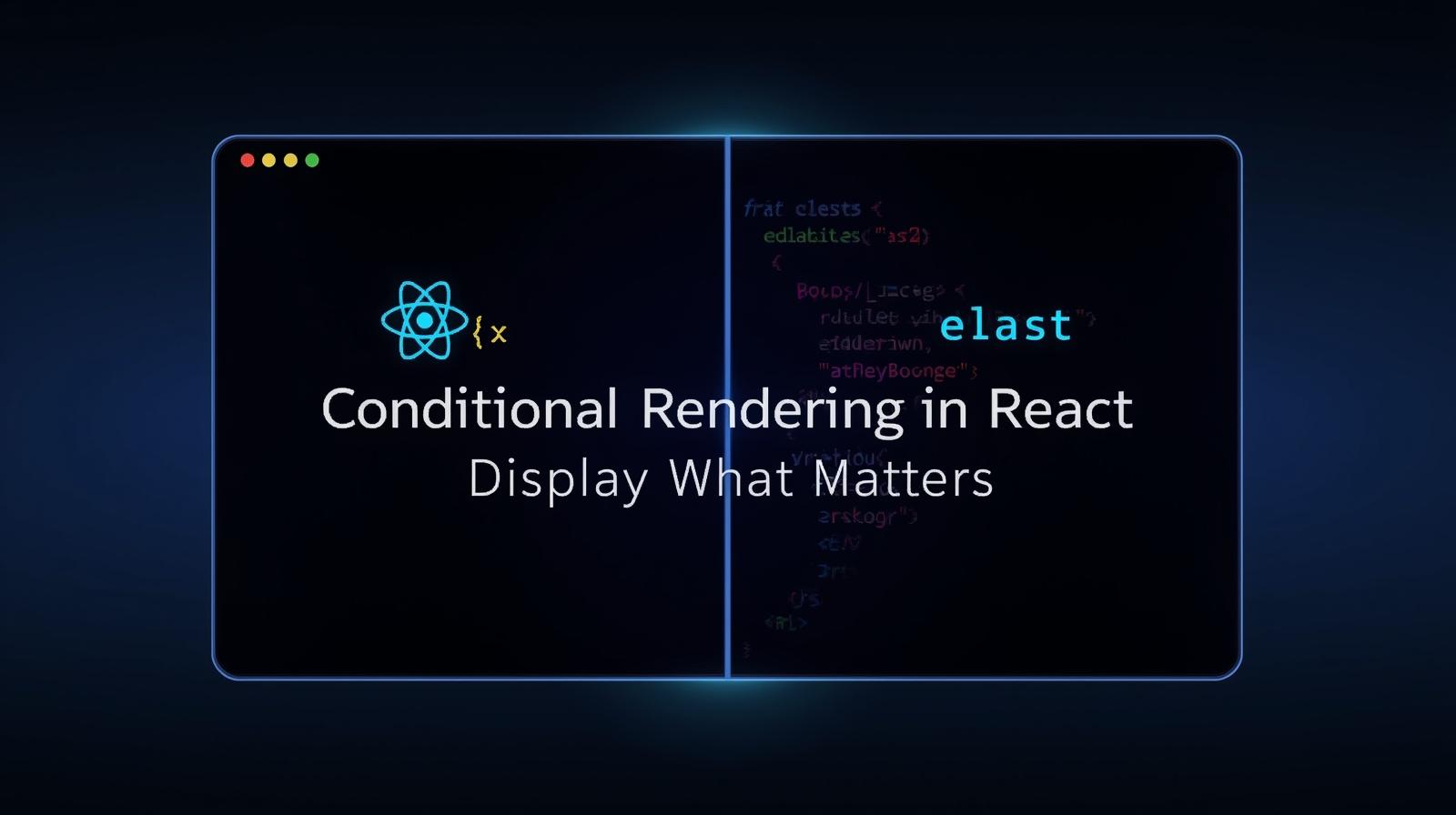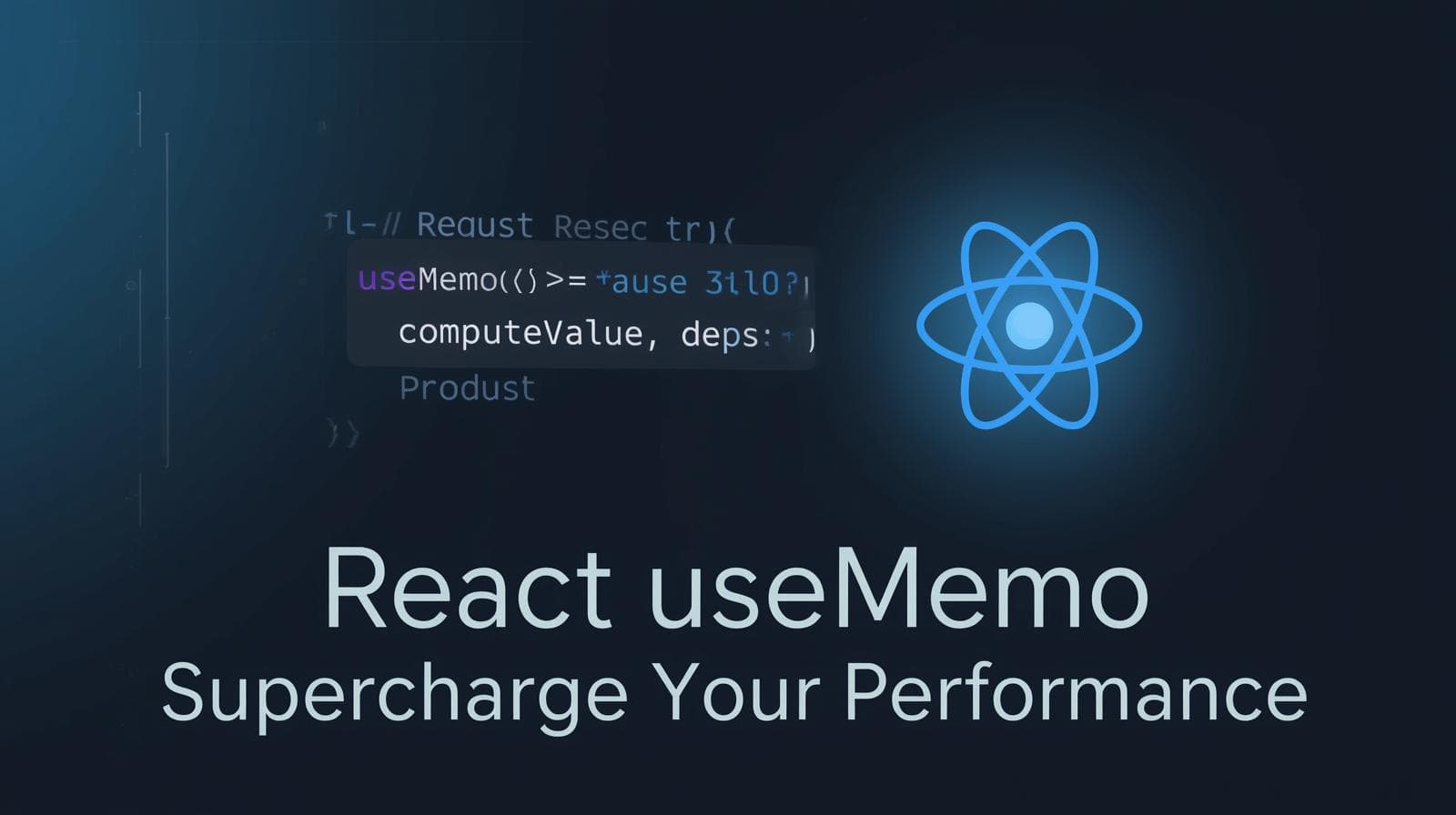Master React Conditional Rendering: A Beginner's Guide with Examples & Best Practices

Unlock the power of React Conditional Rendering. This in-depth guide covers if/else, ternary operators, &&, and more with real-world examples and professional best practices. Level up your skills today!

Master React Conditional Rendering: A Beginner's Guide with Examples & Best Practices
Master React Conditional Rendering: Make Your UIs Dynamic and Smart
Imagine a website where you see a "Login" button if you're logged out, but a "Welcome, User!" message when you're logged in. Or a dashboard that only shows admin controls to, well, admins. Or a loading spinner that appears while your data is fetching.
What’s the common thread? The user interface isn't static; it's dynamic. It changes and reacts based on underlying conditions: user state, data availability, and permissions.
This is the heart of modern web development, and in the React world, it's achieved through a fundamental concept called Conditional Rendering.
If you've ever wondered, "How do I make this component show different things at different times?" then you're in the right place. This comprehensive guide will demystify React Conditional Rendering, walking you through the various techniques, from the simple if/else to elegant shortcuts, complete with real-world examples and professional best practices.
What is Conditional Rendering?
In simple terms, conditional rendering in React is the process of displaying different UI elements or components based on certain conditions. It works exactly like conditional logic in plain JavaScript, but instead of controlling the flow of a function, it controls the flow of your JSX.
Think of it as the if-else logic for your user interface. If a condition is true, render Component A. Else, render Component B.
This is powerful because it allows you to create interactive, stateful applications that respond to user input, data changes, and application state seamlessly.
Why is Conditional Rendering So Crucial?
Without conditional rendering, your React components would be dumb and static, like a printed page. With it, they become intelligent and interactive. It's essential for:
User Authentication: Showing login/logout buttons.
Form Handling: Displaying validation errors or success messages.
State-Dependent UI: Showing loading spinners, error states, or empty state messages.
Feature Toggling: Enabling/disabling features for certain users.
Dynamic Lists: Rendering lists only when data is available.
Diving into the Methods: Your Conditional Rendering Toolkit
Let's explore the most common and effective ways to implement conditional rendering in your React components.
1. The Simple if...else Statement
The classic JavaScript if...else is your most straightforward tool. It's best used for deciding between two distinct blocks of JSX.
Example: Login/Logout Button
jsx
function UserStatus({ isLoggedIn }) {
if (isLoggedIn) {
return <button>Logout</button>;
} else {
return <button>Login</button>;
}
}
// Usage: <UserStatus isLoggedIn={true} />In this example, the entire return value of the component is determined by the condition. It's clear and explicit, but can be verbose for smaller, inline conditions.
2. The Ternary Operator (? :)
The ternary operator is a concise, inline way to handle an if-else scenario. It's perfect for toggling between two expressions or values directly within your JSX.
Syntax: condition ? expressionIfTrue : expressionIfFalse
Example: Profile Link or Guest Message
jsx
function Header({ user }) {
return (
<header>
<h1>My Awesome App</h1>
<div>
{user ? (
<a href="/profile">Welcome, {user.name}!</a>
) : (
<span>Hello, Guest!</span>
)}
</div>
</header>
);
}The ternary operator keeps the logic neatly contained within the JSX, making the code very readable for simple either/or choices.
3. The Logical AND Operator (&&)
This is one of the most useful patterns in React. The && operator is perfect for when you want to render something only if a condition is true. If the condition is false, it renders nothing (or more accurately, the falsy value, which React simply skips).
Example: Admin-Only Dashboard Control
jsx
function Dashboard({ user }) {
return (
<div>
<h2>Dashboard</h2>
{/* Show this button ONLY if the user is an admin */}
{user && user.role === 'admin' && (
<button>Delete User Account</button>
)}
<p>Regular user content here...</p>
</div>
);
}How it works: If user is null or user.role is not 'admin', the entire expression short-circuits and evaluates to that falsy value, causing the button to be omitted from the DOM. It's clean, elegant, and idiomatic React.
4. Handling Multiple Conditions with else-if
Sometimes, you have more than two possible outcomes. In such cases, you can use if...else if...else logic, often outside of the main JSX return.
Example: Status-Based Component Rendering
jsx
function DataComponent({ status, data }) {
let content;
if (status === 'loading') {
content = <Spinner />;
} else if (status === 'error') {
content = <ErrorMessage />;
} else if (status === 'success') {
content = <DataTable data={data} />;
} else {
content = <p>Unknown state.</p>;
}
return <div className="data-container">{content}</div>;
}This approach is highly readable and mirrors how we think about multiple exclusive states.
5. Early Return (Guard Clause)
An "early return" is a pattern where you check for a condition at the top of your component and return early (often null or a placeholder) if that condition is met. This is great for preventing a component from rendering until its necessary data is available.
Example: Preventing Render Without Data
jsx
function UserProfile({ user }) {
// Guard Clause: If no user, don't render the main component.
if (!user) {
return <p>Please log in to view your profile.</p>;
// Alternatively, return null for nothing to render.
// return null;
}
// Main component logic, safe in the knowledge that `user` exists.
return (
<div>
<h1>{user.name}'s Profile</h1>
<img src={user.avatarUrl} alt="Avatar" />
</div>
);
}This simplifies the main JSX by handling edge cases upfront.
Real-World Use Case: Building a Smart Notification System
Let's combine several techniques to build a realistic component.
jsx
function NotificationBar({ notifications }) {
// Early return if there are no notifications
if (!notifications || notifications.length === 0) {
return null; // Render nothing
}
// Check for high-priority, unread notifications
const hasUrgentNotification = notifications.some(
(notif) => notif.priority === 'high' && !notif.read
);
return (
<div className="notification-bar">
{/* Change color based on urgency */}
<h3 style={{ color: hasUrgentNotification ? 'red' : 'blue' }}>
Notifications
</h3>
{/* Show count only if there are notifications */}
<p>You have {notifications.length} new notification(s).</p>
{/* Show a warning only if there's an urgent one */}
{hasUrgentNotification && (
<p className="urgent-warning">⚠️ You have an urgent notification!</p>
)}
{/* List the notifications */}
<ul>
{notifications.map((notif) => (
<li key={notif.id} className={notif.read ? 'read' : 'unread'}>
{notif.message}
</li>
))}
</ul>
</div>
);
}This component uses an early return, the && operator, and a ternary operator to create a dynamic and intelligent UI.
Best Practices and Common Pitfalls
Avoid Inline
if...elsein JSX: JSX doesn't support inlineif/elsestatements. You must use the ternary operator or move the logic outside.Wrong:
{ if (condition) { <Component /> } }Right:
{ condition ? <Component /> : null }
Be Cautious with Falsy Values in
&&: A common bug occurs when a number like0is a valid value. Since0is falsy,count && <div>...</div>would render0instead of the component. Always use boolean conditions.Risky:
{ messages.length && <MessageList /> }Safe:
{ messages.length > 0 && <MessageList /> }
Keep Conditions Readable: If your conditional logic becomes too complex, don't be afraid to break it out into a variable or a separate function.
jsx
// Instead of a long ternary... const canUserEdit = user && (user.role === 'admin' || user.role === 'editor') && !isPostArchived; {canUserEdit && <EditButton />}Prefer Ternary over Nested
&&: For simple either/or choices, a ternary is often clearer than multiple nested&&operators.
Frequently Asked Questions (FAQs)
Q: Can I use switch statements for conditional rendering?
A: Yes, but they are not commonly used directly inside JSX because switch is a statement, not an expression. The typical pattern is to use a switch inside the component's body to set a variable, which you then render in your JSX, similar to the multiple if...else if example.
Q: How do I conditionally apply CSS classes?
A: Use a ternary operator or a helper library like clsx or classnames.
jsx
<div className={`button ${isPrimary ? 'button-primary' : 'button-secondary'}`}>Q: What's the performance impact?
A: Conditional rendering is very performant. React's reconciliation process is efficient at updating the DOM. The key is to ensure your conditions aren't derived from computationally expensive operations on every render. Use useMemo if needed.
Conclusion: Your UI, Now with Logic
Conditional rendering is not just a feature of React; it's a foundational concept that breathes life into your applications. By mastering if/else, the ternary operator, and the logical && operator, you can build UIs that are dynamic, responsive, and deeply engaging for the user.
Remember, the goal is to write code that is not only functional but also clean and easy to understand. Start with the simplest tool that gets the job done, and refactor as your logic grows more complex.
Ready to Build Dynamic, Professional-Grade Applications?
Conditional rendering is just one piece of the puzzle in modern web development. To master React, build complete full-stack applications, and launch your career as a software developer, you need a structured learning path.
To learn professional software development courses such as Python Programming, Full Stack Development, and the MERN Stack, visit and enroll today at codercrafter.in. Our project-based curriculum and expert mentors will guide you from fundamentals to job-ready skills. Build your portfolio, master concepts like conditional rendering in a real-world context, and start crafting the future, one component at a time









